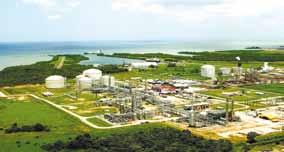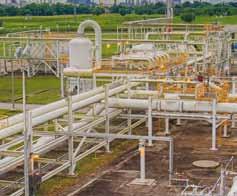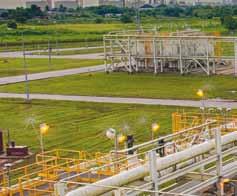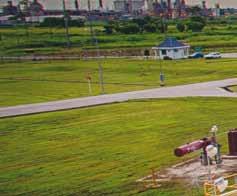
20 minute read
The Convergence of Power, Gas & Renewables
by IGU
By Prof.-Dr. Hartmut Krause, Prof.-Dr. Gerald Linke and Gert Müller-Syring
v Figure 1. With its climate policy goals the German government has set the course for a fundamental transformation of energy supply systems. By 2050, CO 2 emissions in Germany are to be reduced by at least 80% and primary energy consumption by 50%. Higher shares of renewable energies, energy saving and better energy efficiencies are therefore at the top of the political agenda.
The impact of these political requirements is particularly felt in electricity generation. In the last two decades, green power generation has grown from less than 20 TWh to almost 160 TWh (Figure 1) reflecting more than 25% of total German power consumption. In regions with high production capacities and weaker residual demand, the share of renewable power far exceeds 100%, showing clearly that the power grids face severe challenges and have to transport electricity in the opposite direction than they have been designed for 1 .
From today’s viewpoint, successful integration of increasing volumes of power from renewable sources requires expansion and reinforcement of electricity networks, additional load mitigation measures and alternative transportation and storage technologies. The existing gas infrastructure can contribute to make these measures a success, for example, for load mitigation by using bivalent gas assets or the storage of huge
1 Gert Müller-Syring, Marco Henel, Hartmut Krause, Hans Rasmusson, Herwig Mlaker, Wolfgang Köppel, Thomas Höcher, Michael Sterner and Tobias Trost “Power-to-gas –storage concepts for renewable energy” Gas for Energy, no. 01, pp. 40-48, 2012
Development of renewable power production in Germany
Power in GWh
180,000
160,000
140,000
120,000
EEG 1. August 2004 EEG 1. January 2009
100,000
80,000
60,000
40,000 StrEG 1. January 1991
20,000
Novelle BauGB November 1997
EEG 1. April 2000
0 1990 1991 1992 1993 1994 19951996 1997 1998 1999 2000 2001 2002 2003 2004 20052006 2007 2008 2009 2010 2011 2012 2013 2014 Photovoltaics Biomasss* Wind Power Hydro 1)
*solid, liquid, gaseous biomass, waste incl. landfillgas, biogenic fuels. Geothermal not included (share 2012: 25,24GWh) Abbrevations: StrEG - Stromeinspeisegesetz; BauBG - Baugesetzbuch; EEG - Erneuerbare-Energien-Gesetz Source: until 2012 BMU Arbeitsgruppe Erneuerbare Energien-Statistik Stand: Feb. 2013, 2013 AG Energiebilanzen Stand 12/13, 2014 AG Energiebilanzen 12/2014
energy amounts that will be of special importance when the share of green power increases further. Using the potential of the gas infrastructure will result in the beginning of the convergence of the power and gas infrastructures, and later in a combined energy infrastructure with outstanding performance that is significantly better than that of the optimized separate infrastructures. However, using this potential will require modifications in the gas infrastructure such as improving the capacity for green gases or the implementation of information and communication technologies. Depending on the topic, there is need for R&D, implementation activities and, in most cases, regulatory improvement.
Against this background DVGW, the German Technical and Scientific Association for Gas and Water, is examining the role of gas in the future energy system through an innovation initiative.
The goal is to present the potential of natural gas as a suitable partner for renewable energies in order to pave the way for an optimised future energy system.
Challenges meet opportunities
The challenges we face in the transition process of the energy systems are diverse and expected to change with different shares of renewable energies. Nevertheless, for the time being, major challenges can be identified and appropriate mitigation opportunities with different strengths and weaknesses are available. Table 1 presents the challenges and opportunities of using the gas infrastructure.
Even though Table 1 shows remarkable potential leading to a convergence of power, gas and renewables, it is a fact that using this potential requires changes in the gas infrastructure. In some cases existing knowledge needs to be applied, in others the potential of technology has to be demonstrated or new knowledge has to be gained through R&D.
Here we give an overview on selected technologies (opportunities) and their potential for the convergence of the energy system.
Power-to-gas as a basis for the convergence of power, gas and renewables
There are several arguments supporting the power-to-gas concept: investigations by the German Energy Agency state that it is absolutely necessary to expand the electricity network by 850 km for the integration of renewable energy by 2015. Moreover, an additional need for electricity transportation capacities of 1,700-3,600 km may be required depending on the share of renewable energies
c Growth in renewable energy has put pressure on electricity networks.
x Table 1.
Challenges from the energy transition process and opportunities
Challenges Integration of renewable power/load mitigation management Long term energy storage Reduction of CO 2 emissions Opportunities (using gas infrastructure) Power to gas and injection of green gases, CHP, bivalent assets
Power to gas and injection of green gases Green gases and fuels (biogas, H 2 , synthetic natural gas) and improved end use application
v Installing power-to-gas
units can significantly reduce critical situations in the power grid and subsequently the need for grid reinforcement.
achieved by 2020. 234 This would lead to huge technical efforts costing billions 56 . Also, it is becoming increasingly apparent that further development of the power grid is not well supported by society.
2 Federal Network Agency (2011): report in accordance with Sec. 63 (4) (a) of the Energy Industry Act concerning evaluation of the network condition and expansion reports submitted by the German electricity transmission system operators. Federal Network Agency, Bonn.
3 Dena and Consentec (2011): network expansion position paper. Top priority of electricity network expansion. Network expert panel. Berlin, 1 June 2011.
4 Deutsche Energie-Agentur GmbH: dena network study II-summary, 2010. pp. 13 www.dena.de/fileadmin/user_ upload/Publikationen/Erneuerbare/Dokumente/ Ergebniszusammenfassung_dena-Netzstudie.pdf
5 Deutsche Energie-Agentur GmbH: dena distribution network study –factsheet, 2012. pp. 1 www.dena.de/fileadmin /user_upload/Publikationen/Erneuerbare/Dokumente/ Ergebniszusammenfassung_dena-Netzstudie.pdf
6 Federal Ministry of Economics and Technology, 2011. pp. 48-54 www.bmwi.de/BMWi/Redaktion/PDF/ Publikationen/Studien/verteilernetzstudie,property=pdf,b ereich=bmwi2012,sprache=de,rwb=true.pdf

Power-to-gas as a technology offers to combine the power and gas grids by converting power to gases that, following injection into the existing gas infrastructure, can be reconverted into electricity, heat or fuel as required. Germany and the rest of Europe have already developed efficient gas networks. The German gas network has a storage volume corresponding to more than a third of Germany’s total annual electricity generation and offers high flexibility at high transportation capacities over large distances. The gas network transports an annual energy quantity of around 1 trillion kWh and thus about twice as much as the electricity network. Currently, a volume of 20% of the annual gas consumption is held available in underground storage facilities. Thus, the natural gas network is not only an extensive energy distribution system interconnected on a Europe-wide level but also offers substantial energy storage capacity; this is an important difference compared to the
Energy has a new name.
www.uniper.energy
electricity network where non-simultaneous injection and withdrawal of energy is not possible. Moreover, the gas infrastructure is an existing, socially accepted and very reliable infrastructure and therefore an important partner of the energy transition.
Beyond enabling the use of outstanding energy storage capacities, the implementation of power-to-gas can mitigate the load in the power grids. In order to quantify the possible effects, especially in rural areas with huge amounts of generated renewable electricity, a DVGW R&D project has been initiated. In the north of Germany, where renewable electricity production already exceeds demand at most times of the year, the effect of power-to-gas facilities has been investigated by a research group. The group members DBI Gas Technology Institute, University of Wuppertal, DVGW Research Center Engler-Bunte and RWTH Aachen University were coordinated for DVGW by Heinrich Busch. EWE Netz and E.ON Avacon strongly supported the project as industrial partners.
The investigations showed that installing power-to-gas units in the low voltage grid with a capacity of up to a few hundred kilowatts can significantly reduce critical situations in the power grid and subsequently the need for grid reinforcement. The calculations showed furthermore that this positive effect is being passed to higher voltage tiers as well. This is possible due to the reduced amount of power that is fed back into higher voltage tiers from the low voltage grid. In order to realize this potential, power-to-gas technology has to be implemented quickly (in less than ten years) otherwise the electricity grid reinforcement will have taken place, leaving no room for power-to-gas in terms of load mitigation. The precondition for implementing the technology in the coming years is to achieve investment costs in the magnitude of €1,000/kW installed, including the injection facility, which is an important technology goal.
Finally, the study revealed that adding up the individual benefits that power-to-gas offers, when implemented in the low voltage grid, for load mitigation and subsequent reduction of grid reinforcement, as well as better aligning forecast and real delivery of renewable energy, contributes to the viability of this technical solution.
This makes using power-to-gas competitive in comparison to reinforcing the power grid if cable reinforcement is needed, which is increasingly expected to be the case in future. 7
H2 tolerance of the gas grid
Hydrogen and methane are both chemical energy carriers that can be produced by powerto-gas technology. Both options have different strengths and weaknesses. Hydrogen production leads to lower capital and operational expenditures, but requires modifications of the gas infrastructure depending on the share of hydrogen. Converting hydrogen to methane reduces efficiency and results in increased production costs. On the other hand, modifications in the gas infrastructure are unnecessary. In order to decide how the installed power-to-gas capacity should be distributed in terms of hydrogen or methane injection, a macroeconomic evaluation is mandatory. This decision mainly depends on the production costs for the synthetic gases as well as the costs for modifying the gas infrastructure to host hydrogen. A significant level of knowledge has already been achieved regarding admissible hydrogen concentrations in the gas grid. But some questions remain, as earlier experiences with hydrogen in town gas
7 M.Eng. Jens Hüttenrauch, M.Eng. Sylvana Zöllner, Dipl. Ing. (FH) Gert Müller-Syring, M.Sc. Philipp Steffens, Dr. Marcus Stötzel, Prof. Dr. Markus Zdrallek, Dipl.-Ing. Wolfgang Köppel, Dipl.-Phys. Charlotte Degünther, M.Sc. Christoph Baumann, Dipl.-Wi.-Ing. Kilian Geschermann, Univ.-Prof. Dr.-Ing. Albert Moser “Nutzen der Power-toGas-Technologie zur Entlastung der 110-kVStromverteilungsnetze” energie | wasser-praxis 4/2015
Current state of knowledge “H₂-tolerance results from DVGW project G 1/02/12”
are not fully transferable to the current situation and R&D performed more recently has not yet covered all of the components in the gas grid that may be sensitive to hydrogen. Nevertheless, available results, from a recently finalized GERG (European Gas Research Group) project (HIPS), 8 and a DVGW project 9 on hydrogen tolerance show that most parts of the existing gas grid are compatible with hydrogen concentrations up to 10% by volume (Figure 2). These projects identified ◆ ◆ ◆ ◆
Porous underground gas storage
Steel CNG vehicle tanks
Gas turbines and engines
Industrial burners as sensitive components which require
8 www.gerg.eu/public/uploads/files/publications/ GERGpapers/HIPS_-_the_paper_-_FINAL.pdf, January 2014
9 “Wasserstofftoleranz der Erdgasinfrastruktur inklusive aller assoziierter Anlagen” (February 2014) www.dvgwinnovation.de/die-projekte/archiv/wasserstofftoleranz/
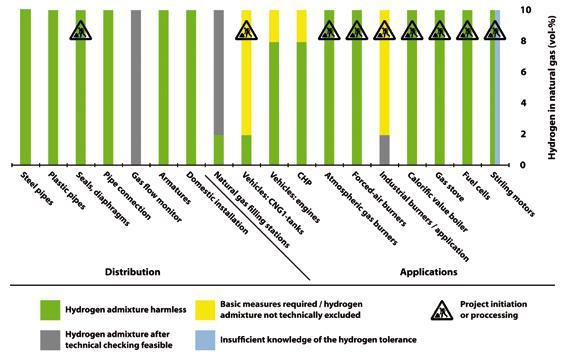
further research to determine their tolerance to hydrogen admixtures.
There are several research projects and initiatives, either under way or in preparation, to close the knowledge gaps, especially focusing on the above-mentioned key issues.
A European understanding of admissible hydrogen concentrations in gas infrastructure is urgently needed in order to create a sound basis for future standardization. This requires the collection and combination of results from the above-mentioned R&D projects. To achieve this goal DBI has initiated the “HIPS-NET” network, supported by GERG, to gather and share the available and expected research results in order to develop the needed European understanding of gas grid tolerance towards hydrogen. More than 30 international partners from various industries, e.g. gas grid operators, turbine and automobile manufacturers as well as research institutes,
c Figure 2.
have joined HIPS-NET so far. The composition and diversity of the network reveals the strong interest in closing existing knowledge gaps on the hydrogen tolerance of the existing gas grid 10 .
Besides HIPS-NET focusing on technical issues, two standardization activities have recently been launched. “HYREADY” initiated by DNV GL and supported by DBI as a joint industrial project aims to develop a DNV GL-recommended practice that gives guidance especially to gas network operators, when hydrogen is injected into gas grids. This group is open to further members.
Initiated by CEN, CENELEC and EARTO and convened jointly with the Joint Research Centre (JRC), a Sector Forum Energy Management Working Group on Hydrogen has been established. By the end of 2015 the group aims to provide recommendations in order to support a standardization of hydrogen in the area of production. The project intends to identify and solve especially pre-normative challenges. In order to succeed, the following five task forces have been established: ◆
TF 1: Electricity grid connection
TF 2: Electrolyzers and hydrogen storage
TF 3: HCNG, gas infrastructure and applications
TF 4: Hydrogen infrastructure and applications
TF 5: Cross cutting 11
The selected activities of various stakeholders express the importance, as well as the urgency of making steps forward in order to extend the benefits of existing gas infrastructure for the energy transition.
10 Gert Müller-Syring, Stefan Schütz, Dave Pinchbeck “Establishing a pan-European understanding of admissible hydrogen concentrations in the natural gas system” IGRC 2014 (presentation) www.ufz.de/index. php?en=33355
11 Draft Minutes SFEM Working Group HYDROGEN –Kick-off meeting, 9 February, 2015 Gas grid evolution
As mentioned before, the integration of green gases, e.g. biogas, hydrogen or synthetic natural gas, is an important task and precondition for a successful energy transition. In principle, the gas infrastructure can offer outstanding storage and transport capacities. Nevertheless, it can be challenging to inject green gases into the gas grid at the point of their production as this is often in rural areas with less sophisticated infrastructures and low gas demand.
There are technical measures such as recompression to higher-pressure tiers that enable gas injection into almost every grid section, but the cost-effectiveness of these solutions is questionable.
A very promising approach is the strategic use of the existing grid buffer (differences between highest and lowest allowable pressure) named “dynamic pressure control” (DPC).
In distribution and regional transportation grids with maximum operational pressures above 1 bar, a strategic pressure-driven operation may allow green gas injection without any additional measures, as well as in challenging situations such as summertime nights when the load is exceptionally low in most areas. This could be achieved by a pressure reduction, for example in the evening hours, in order to enable uninterrupted green gas injection overnight, when the load is low, accompanied with a pressure build up. In order to properly assess the opportunities of this approach, it is also important to know what precondition (such as the needed pressure swing, geometric grid volume, customer distribution, etc.) has to be fulfilled.
These questions, as well as the suitability of this approach, were exemplarily answered by an R&D project carried out for EWE Netz GmbH by DBI. The R&D project shows the potential of dynamic pressure control for selected gas grids in the north of Germany.
Effect of dynamic pressure control
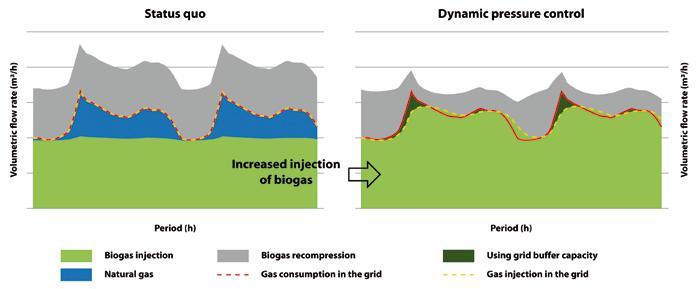
z Figure 3.
This study explored two network areas under different angles: ◆
Enhanced biogas feed-in in rural areas
Optimized procurement of natural gas in urban areas
In order to evaluate the potential of the DPC approach, the gas flow in both networks was simulated using a program called STANET®. The current demand-orientated operation mode of the gas network has been compared with different scenarios (heavy, light, and medium gas demand). By varying the research conditions, for instance: ◆
Upper and lower pressure limits of the gas network
Feed-in pressure of the gas pressure regulating station (GPRS)
Feed-in pressure of the biogas grid injection station
The results (Figure 3) of the investigations for the weak load case in rural areas show that: ◆
DPC leads in the analyzed network to a gas supply solely of biogas
The compression energy can be reduced by up to 89%
For the heavy load case: ◆ Biogas can be completely injected into the middle-pressure distribution network ◆ The compression and feed-in to the highpressure transmission network is no longer necessary
Furthermore, the available grid flexibility leads to a cutting of peak demand by 5% in urban areas.
It can be concluded that dynamic pressure control can significantly improve the ability of rural gas grids to accommodate especially biogas. The required adoptions (setting injection pressure limits twice a year) can easily be achieved. Moreover, peak gas demand can be smoothed but this requires a daily adoption of the pressure limit and therefore technical adoption of the gas pressure regulating stations. Dynamic pressure control is considered an effective and easy-to-install measure to improve the integration capacity for biogas but its potential is location specific 12 .
12 Gert Müller-Syring, Manfred Ahlers, Sylvana Zöllner, Jens Hüttenrauch, Klaus Diesel “Dynamic pressure control in gas grids for better integration of green gases –a potential analysis in the North of Germany” IGRC 2014 (paper) members.igu.org/old/IGU%20Events/igrc/igrc2014/papers/tw2-3_mueller-syring.pdf
Conclusion
The energy transition is especially challenging to infrastructures because they have to accommodate renewable energies that are: ◆
Mainly produced decentralized
Spatially and, in terms of the time of production, not aligned with demand
Changing their contribution to feeding demand extremely quickly (production ramps in green power generation such as wind and solar)
The stress on power grids is currently very high and expected to increase steadily. The convergence of gas and power infrastructures forms a unique opportunity to integrate renewable energies into the existing energy infrastructure. This integration reduces the need for power grid extension and reinforcement, thus, the complementary strengths of both systems compensate their weaknesses.
An important integrating technology is power-to-gas. Providing a sensitive implementation, it enables the utilization of the huge storage capacities of the gas infrastructure that is needed in the medium and long term and offers load mitigation for the power grid with effects on all voltage tiers resulting in a reduced need for grid extension/reinforcement in the short term. The results of the DVGW investigations show, furthermore, that the benefits of load mitigation in the different power grids can support the viability of power-to-gas. In comparison to power grid reinforcement by ground cables, that are expected to be increasingly used due to societal pressure on infrastructure development, power-to-gas turned out to be the cost-efficient alternative.
Innovative approaches are available to prepare the gas infrastructure in order to make its potential available for the energy transition. The accommodation potential of biogas in rural gas distribution grids can be significantly improved by applying a dynamic pressure operation, which can be easily applied at low costs.
The important issue of establishing a European understanding of the admissible hydrogen concentration in the gas grid is addressed by various projects and initiatives such as HIPS-NET and HYREADY. Moreover, CEN and CENELEC are conducting, together with the JRC, a SFEM Working Group on Hydrogen aiming to prepare a European standardization.
It can be concluded that a significant effort is being made to prepare the gas infrastructure for an active role in the energy transition. Nevertheless, efforts have to be focused to address open issues and to bring already available high potential technologies/ approaches into the market and establish them in the infrastructures.
Prof.-Dr. Hartmut Krause is Managing Director of DBI Gas- und Umwelttechnik GmbH. Prof.-Dr. Gerald Linke is Managing Director of DVGW, IGU Executive Committee Member and Chair of the R&D and Innovation Committee. Gert Müller-Syring is Head of Department Gas Grids/Gas Facilities, DBI Gas- und Umwelttechnik GmbH.
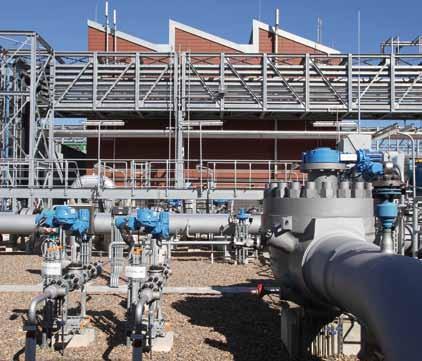
x Gas storage at Etzel in
northern Germany. Powerto-gas technology combined with large gas storage capacities will greatly aid the energy transition.
The National Gas Company of Trinidad and Tobago
When The National Gas Company of Trinidad and Tobago Limited (NGC) was incorporated in 1975, it was to act as a trigger for Government to capture value from natural gas development. Four decades on, NGC, at the heart of natural gas based development, has burgeoned into a dynamic, diversified group of companies.
Now exciting prospects are in the pipeline as NGC Group of Companies gets set to go global.
NGC is a diversified group of companies with an asset base of over $6.5 billion, making it one of the largest in the Caribbean and Latin America when measured by assets. It is an internationally investment-rated company and its credit rating, as at January 2016, is A- from Standard & Poor’s, Baa2 from Moody’s and AAA from CariCRIS.
The NGC Group
The parent, The National Gas Company of Trinidad and Tobago Limited is strategically positioned in the midstream of Trinidad and Tobago’s natural gas value chain and together with its subsidiaries operates in the downstream and upstream sectors. NGC core activities are in gas-based development and merchandizing; natural gas aggregation, transportation and distribution; natural gas pipeline construction, operation and maintenance; Liquefied Natural Gas (LNG) production, marketing and shipping; and oil and gas production and marketing. As the sole seller and distributor of natural gas in the country for local power generation and the domestic sector, NGC is fittingly headquartered in the Point Lisas Industrial Estate – a bustling hub of petrochemical and heavy industrial plants that rely on natural gas to fuel their operations.
The Company’s key infrastructure, however, extends far beyond the west-central coast industrial estate. NGC owns and operates a network of marine and onshore pipelines that span 1,000 km with a capacity of 4.4 billion cubic feet of gas per day. Its customers comprise power generation plants, world-scale petrochemical metal reduction plants, and a wide range of light manufacturing and commercial enterprises.
There are three main subsidiary companies: National Energy Corporation of Trinidad and Tobago Limited (National Energy) which conceptualizes, promotes, develops and manages industrial sites, port and marine; Phoenix Park Gas Processors Limited (PPGPL) is engaged in natural gas processing and the aggregation, fractionating and marketing of Natural Gas Liquids (NGLs) propane, butane and natural gasoline to Latin America and the Caribbean; and most recently, in a pioneering effort to impact the domestic integration of gas utilization, a campaign to promote Compressed Natural Gas (CNG) as a cleaner, cheaper fuel into the country’s transportation sector has been launched, and has tasked the NGC CNG Company Limited (NGC CNG), NGC’s newest subsidiary.
Corporate with a conscience
NGC’s raison d’être was to enable the nation at large to benefit from the country’s resource wealth, and today its enormous contribution to Trinidad and Tobago’s GDP sees this mandate being fulfilled. Beyond that contribution, however, the Company actively seeks to enrich the lives of citizens through various Corporate Social Responsibility programmes and initiatives under the areas of Sport, Civic Life Empowerment and the Environment. Among its many social activities, NGC supports cricket and athletics programmes, literary and arts festivals, training and education initiatives, musical ensembles, and facilities and community economic development.
As an entity engaged in resource development, the NGC Group also recognizes the need for operational sustainability and has made a commitment to reduce its ecological footprint through a reforestation initiative. As at the end of 2015, NGC has returned more than 260 hectares of deforested land under leaf and bark.
Going global
Trinidad and Tobago is a developing nation that has experienced significant growth in recent years, and the country is poised to lead others through its example. Well-endowed with oil and gas, the nation has been able to successfully manage the monetization of its resources.
The NGC Group’s operations have been integral to that success, and this makes it an ideal business partner. In fact, the expansion into new and global markets is one of the Company’s strategic pillars, and driven by this imperative, it is seeking to export Trinidad’s model of natural gas-based development to other countries. Specifically, options are currently being explored in jurisdictions wishing to replicate Trinidad and Tobago’s success at monetizing natural gas and related businesses. The NGC Group is also embarking on an initiative to establish a commodity trading business to manage the Group’s current energybased commodities as well as to expand and grow the portfolio.

